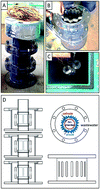Current recovery from sewage wastewater using electrochemically oxidized graphite felt†
Abstract
The oxidation of a carbon anode has been reported to enhance electricity recovery in a microbial fuel cell (MFC). This study investigates the applicability of electrochemically oxidized graphite felt (EOGF) as the anode for the recovery of electricity from sewage wastewater when polarized at 0.2 V during MFC operation. EOGFs were prepared by polarizing graphite felt (GF) at 2 V in 1% sulfuric acid or nitric acid. The nitric acid-treated EOGF inoculated with an sewage sludge produced a maximum current of 110 μA cm−3, which exceeds that produced by the original GF (91 μA cm−3) under electrochemical cultivation at 0.2 V vs. Ag/AgCl. This outcome is attributed to a decrease in charge-transfer resistance and an increase in the capacitance of the anode. In contrast, electrochemical oxidation did not affect the chemical oxygen demand (COD) removal rate or the microbial community structure of the anode. The MFC equipped with the EOGF delivered 340–560 mW m−3-MFC of electricity during operation in the drainage water channel of a primary sedimentation tank, which corresponds to 11–15 μA cm−3 of current density. The lower current produced in the MFC compared to that observed during electrochemical cultivation indicates that factors other than the anode material restrict current production in the MFC. Even with the small amount of generated electricity, when operated for more than three days, the MFC provides a positive net energy balance when integrated with post-aeration treatment.



 Please wait while we load your content...
Please wait while we load your content...